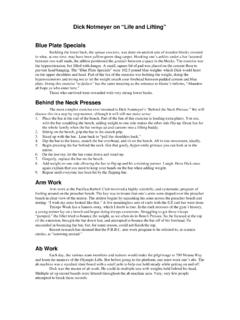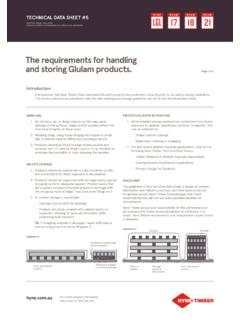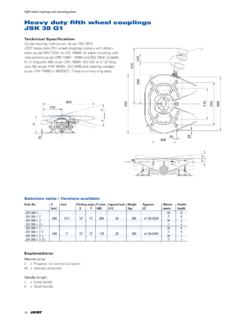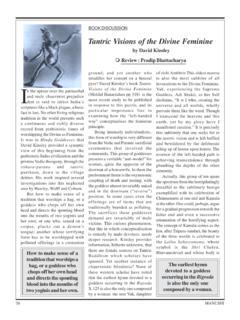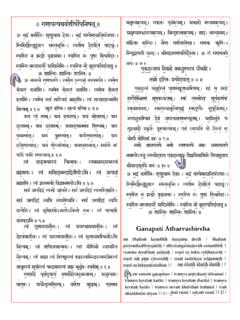Transcription of ATTRIBUTING PERFORMANCE IN FUND OF FUNDS
1 ATTRIBUTING PERFORMANCE IN fund OF FUNDS By Arun Muralidhar Chairman, Mcube Investment Technologies LLC Managing Director, FX Concepts, Inc. Background The hedge fund industry has seen enormous growth as institutional investors pour money into this area. This has led to the proliferation of hedge FUNDS and in turn, fund -of- FUNDS (FoFs). Since many institutional FUNDS feel that they do not have the ability to evaluate managers themselves or could not get access to all the managers they would want to, the FoF becomes a useful intermediary. However, these institutions add on their fees to the fees of the hedge FUNDS .
2 In many cases, the have a fixed fee and a PERFORMANCE fee in addition to similar fees paid to the managers. As a former plan sponsor, I feel it is incumbent on clients to explore whether the fees justify the value-added. However, the term value-added in this business is a little fuzzy. In short, in this note we attempt to address this issue and to lay out an analytical process by which clients can better understand how value is added by FoFs as there is clearly a need for a methodology both for clients as well as senior management at such organizations.
3 Critically, it is important to know (a) how well a FoF has done relative to peers; and (b) important to know the sources of return. It is interesting that two recent articles in the AIMA Journal, April 2004, address some of these issues and all of this is likely to stir up more controversy than it resolves, but if nothing else it will start the debate on the sources of value-added and how they are captured and discussed with There are many difficulties in doing such analyses and peer comparison, even for pension FUNDS and endowments, is tough in general.
4 Muralidhar (2001) highlights the difficulty in comparing pension FUNDS or endowments as each fund has a different strategic allocation to However, PERFORMANCE attribution ( , how the total return breaks down) is relatively easy as a pension fund s PERFORMANCE can be broken down by the key decisions made by the fund ; namely: (a) strategic allocation to broad asset classes; (b) tactical deviations from these asset classes; (c) benchmark risk taken by pension staff to assign benchmarks different from those at the fund level to those assigned to managers ( , the fund will be measured to the Russell 3000, but staff assign a Russell 2000 benchmark to a manager); (d) manager selection.
5 And (e) manager In addition, Muralidhar (2001), Chapter 14, shows that often such analyses have low information content and hence any PERFORMANCE comparison needs to be qualified by how confident one can be that any positive PERFORMANCE contribution is truly from skill and not from luck. The skill versus luck analysis is conditioned on the track record of the decision relative to a clearly 1 See I. Morley (2004). Hedge fund Indices: A Measure of PERFORMANCE or The Hangman s Noose for Hedge FUNDS ? AIMA Journal, April 2004, and M.
6 Howell (2004). What s My Style? A Tactical Guide to Choosing Hedge fund Styles. AIMA Journal, April 2004. 2 See A. Muralidhar (2001). Innovations in Pension fund Management, Chapter 14, Stanford University Press. 3 J. Geenen, M. Heemskerk, and M. Hereema (2002). Decision-based Evaluation of Hierarchically Structured Investment Process. Journal of PERFORMANCE Measurement. See also See A. Muralidhar (2001). Innovations in Pension fund Management, Chapter 9, Stanford University Press. articulated benchmark and the length of data history. Given the short histories in the hedge fund industry, this is likely to be a The case of fund -of- FUNDS Hedge fund FoFs present a totally different set of challenges to the analyst that seeks to establish the sources of return and compare one fund to another.
7 First, there are many types of FoFs that have entered the arena and not all overlap in what they cover ( , multi-strategy or specialized FoFs). Second, they all adopt different degrees of leverage and hence this needs to be controlled for. In comparing two different portfolio managers, it is important to normalize PERFORMANCE for risk taken, and the question is whether the risk measure is an absolute one or relative to some Third, clients and FoFs often have not established marketable, replicable benchmarks to which they can be measured. Often, at the behest of the manager, the FoF is measured relative to a cash benchmark such as LIBOR (with often the client not realizing that they are bearing the risk that LIBOR collapses as was the case between 2001 and 2004).
8 6 Fourth, even if such benchmarks exist, very few FoFs (or clients) have strategic allocations to hedge fund sectors and often FoFs are a collection of the bottom-up selection of managers. Finally, many investments in this area are very illiquid because of lock ups. Hence peer comparison and attribution are very difficult. As a result, we only focus on attribution in this note and address risk adjustment and peer comparison in a separate note. Attribution The value-added in an attribution analysis has got to be relative to some passive numeraire, so let us start with the assumption that while a client would like to receive LIBOR + 4 or 5%, since all PERFORMANCE fees are paid for PERFORMANCE in excess of LIBOR, the de-facto strategic allocation is 100% to LIBOR.
9 From here, the key decisions that add value in a FoF are (a) a strategic allocation to various hedge fund sectors probably non-existent for most FoFs in this business (but recognize that even a 0% allocation can be strategic)7; (b) tactical allocations relative to the strategic most FoFs claim to add value through knowing which sector will do well and want a cut of PERFORMANCE therefore, this should be a dominant component of PERFORMANCE for such FoF; (c) manager selection/manager allocation or was the best manager given the appropriate amount of money and this component should dominate for bottoms-up FoFs; 4 See A.
10 Muralidhar (2003). Skill, History and Risk-Adjusted PERFORMANCE . Journal of PERFORMANCE Measurement, for a description of how the length of history of managers can be a key input in manager evaluation. 5 See A. Muralidhar (2001). Innovations in Pension fund Management, Chapter 9, Stanford University Press. This chapter discusses how different measures of risk-adjusted PERFORMANCE apply for different investor situations. See also, F. Modigliani and L. Modigliani (1997). Risk-Adjusted PERFORMANCE . Journal of Portfolio Management. 6 This is addressed in A. Muralidhar and S. Krishnamurthi (2003). LIBOR-rating Absolute Return Strategies. Unpublished working paper ( ).

